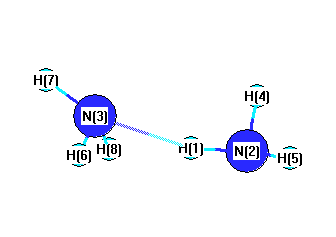Vibrational Frequencies calculated at B3LYP/6-311+G(3df,2pd)
| Mode Number |
Symmetry |
Frequency
(cm-1) |
Scaled Frequency
(cm-1) |
IR Intensities
(km mol-1) |
Raman Act
(Å4/u) |
Dep P |
Dep U |
|---|
| 1 |
A' |
3592 |
3464 |
8.25 |
|
|
|
| 2 |
A' |
3554 |
3427 |
59.28 |
|
|
|
| 3 |
A' |
3474 |
3350 |
2.45 |
|
|
|
| 4 |
A' |
3431 |
3308 |
92.73 |
|
|
|
| 5 |
A' |
1667 |
1607 |
15.69 |
|
|
|
| 6 |
A' |
1658 |
1598 |
15.42 |
|
|
|
| 7 |
A' |
1058 |
1020 |
102.87 |
|
|
|
| 8 |
A' |
1049 |
1012 |
185.11 |
|
|
|
| 9 |
A' |
372 |
359 |
48.13 |
|
|
|
| 10 |
A' |
129 |
125 |
24.77 |
|
|
|
| 11 |
A' |
93 |
90 |
56.88 |
|
|
|
| 12 |
A" |
3594 |
3466 |
7.12 |
|
|
|
| 13 |
A" |
3591 |
3462 |
1.90 |
|
|
|
| 14 |
A" |
1688 |
1628 |
10.85 |
|
|
|
| 15 |
A" |
1664 |
1604 |
18.93 |
|
|
|
| 16 |
A" |
251 |
242 |
40.10 |
|
|
|
| 17 |
A" |
118 |
113 |
35.78 |
|
|
|
| 18 |
A" |
23 |
22 |
14.40 |
|
|
|
Unscaled Zero Point Vibrational Energy (zpe) 15502.9 cm
-1
Scaled (by 0.9642) Zero Point Vibrational Energy (zpe) 14947.9 cm
-1
See section
III.C.1 List or set vibrational scaling factors
to change the scale factors used here.
See section
III.C.2
Calculate a vibrational scaling factor for a given set of molecules
to determine the least squares best scaling factor.
Charges, Dipole, Quadrupole and Polarizability
Charges from optimized geometry at B3LYP/6-311+G(3df,2pd)
Charges (e)
| Number |
Element |
Mulliken |
CHELPG |
AIM |
ESP |
| 1 |
H |
0.220 |
|
|
|
| 2 |
N |
-0.425 |
|
|
|
| 3 |
N |
-0.358 |
|
|
|
| 4 |
H |
0.104 |
|
|
|
| 5 |
H |
0.104 |
|
|
|
| 6 |
H |
0.130 |
|
|
|
| 7 |
H |
0.112 |
|
|
|
| 8 |
H |
0.112 |
|
|
|
Electric dipole moments
Electric dipole components in Debye
(What's a Debye? See section
VII.A.3)
| |
x |
y |
z |
Total |
| |
0.890 |
-2.185 |
0.000 |
2.359 |
| CHELPG |
|
|
|
|
| AIM |
|
|
|
|
| ESP |
|
|
|
|
Electric Quadrupole moment
Quadrupole components in D Å
Polarizabilities
Components of the polarizability tensor.
Units are
Å
3 (Angstrom cubed)
Change units.
| |
x |
y |
z |
| x |
0.000 |
0.000 |
0.000 |
| y |
0.000 |
0.000 |
0.000 |
| z |
0.000 |
0.000 |
0.000 |
<r2> (average value of r
2) Å
2
| <r2> |
72.217 |
| (<r2>)1/2 |
8.498 |
